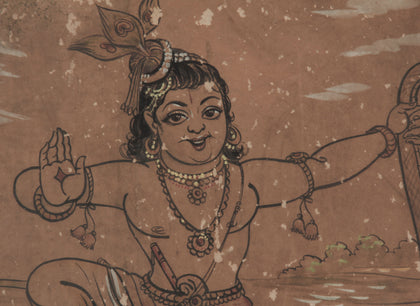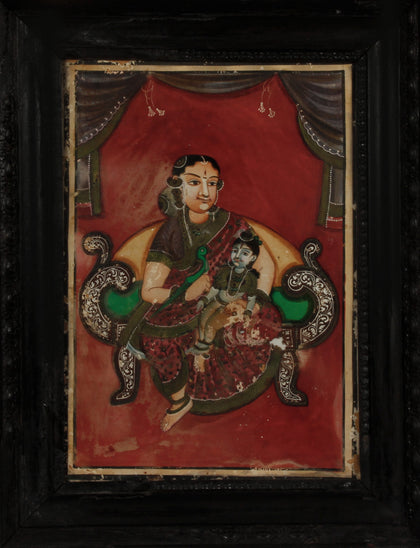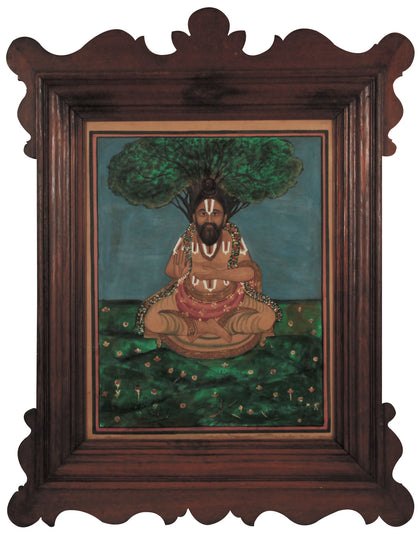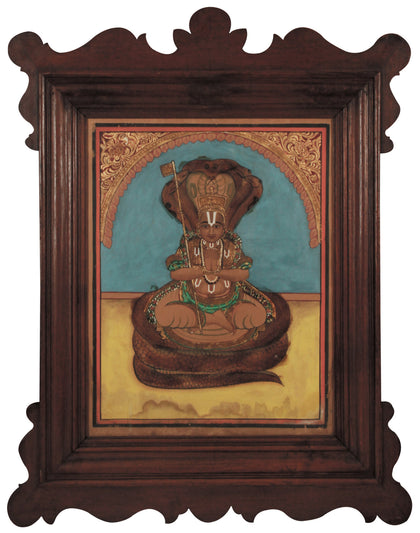Loading...
Rajarajeshwari
Price on Inquiry
All orders are insured for transit.
This item cannot be shipped outside India.























































Please enter the email address linked to your Artisera account, and we will send you a link to reset your password.
Sign Up to access your Wish List and hear from us on all that’s new!
Loading...
All orders are insured for transit.
This item cannot be shipped outside India.
All orders are insured for transit.
This item cannot be shipped outside India.
| Size: | 21 x 19 inches (Framed) |
| Medium: | Mysore Painting |
| Signature: | Bottom Right |
| Year: | 2008 |
The former state of Mysore established a unique and distinctive form of painting that came to be known as the Mysore School in the 17th and 18th centuries. This classical style of South Indian painting was initially born out of the dissolution of the Vijaynagara Empire in 1565. The rulers of Vijaynagara had been great patrons of the arts. When the artisans lost this patronage, they migrated to other areas such as Tanjore, Mysore and Shorapur, looking for work. Absorbing local techniques, their styles changed over time to form the different schools of paintings that are famous in South India even today.
The genesis of the Mysore School of painting can be traced back to the rule of Raja Wodeyar I (1578–1617), who provided patronage to several families of painters of the Vijayanagara School in his capital Srirangapatna. Subsequent rulers also patronised these painters, commissioning them to work on palaces and temples. Up until that point, Mysore paintings were mostly murals, and very few of those survive today. The ruler Krishnaraja Wadiyar III, who was the twenty second Maharaja of Mysore, from 1799 to 1868, put a renewed effort into encouraging the arts. Many of the traditional paintings of the Mysore School which have survived until today, belong to this reign or later. These paintings were used for domestic worship and served as a portable puja altar.
Mysore paintings often get compared to or confused with the more well-known Tanjore paintings, but the two styles are quite distinct. Mysore paintings are more delicate and feature softer colours, finer brushwork and more intricate gesso work. The subjects portrayed in Mysore paintings also tend to be more varied than Tanjore paintings, even though they both depicts gods, goddesses, and stories from Hindu mythology.
The first stage of creating a Mysore Painting was to prepare the base, which could be paper, wood or cloth. The paper board was made of paper pulp or wastepaper, which was dried in the sun and then rubbed smooth with a polished quartz pebble. Cloth was pasted onto a wooden board and then dried and burnished. Wood surfaces were prepared by applying dry white lead, yellow ochre and gum. The colours used to create Mysore Paintings were vegetable based or extracted from minerals and flowers. The long-lasting quality of the natural colours ensure that original Mysore paintings still retain their freshness and lustre even after decades have gone by. Brushes were made with squirrel hair for delicate work. For drawing fine lines, blades of a special variety of grass had to be used. Finally, the figures would be decorated using gesso work. Gesso is a paste mixture of white lead powder, gambose and glue. The gesso work in Mysore paintings is low in relief compared to the thick gold relief work of the Tanjore School. Gesso was used in Mysore painting for depicting intricate designs of clothes, jewellery and architectural details on pillars and arches that usually framed the deities.
| Size: | 21 x 19 inches (Framed) |
| Medium: | Mysore Painting |
| Signature: | Bottom Right |
| Year: | 2008 |
All orders are insured for transit.
This item cannot be shipped outside India.
This item has been added to your shopping cart.
You can continue browsing
or proceed to checkout and pay for your purchase.
This item has been added to your
shopping cart.
You can continue browsing
or proceed to checkout and pay for
your purchase.
This item has been added to your wish list.
You can continue browsing or visit your Wish List page.
Are you sure you want to delete this item from your Wish List?
Are you sure you want to delete this
item from your Wish List?

Thank you for sharing your email address!
You’ll shortly receive a Welcome Letter from us.
Please check your spam folders if you can’t
locate the email in your inbox.
Thank you for sharing your email address! You’ll shortly receive a Welcome Letter from us. Please check your spam folders if you can’t locate the email in your inbox.


















